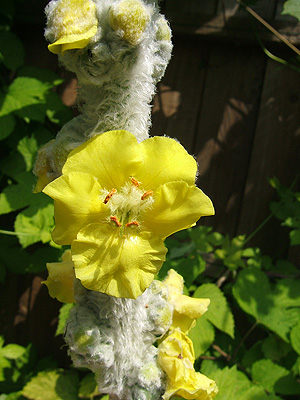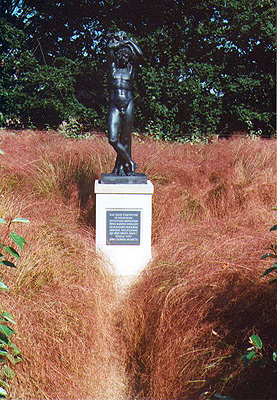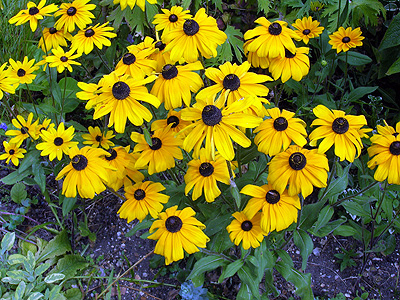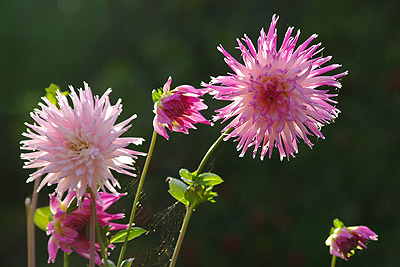The Garden in August - Jobs and Tips
plants for August
Jobs / Tips
![]() Keep dead-heading all flowering plants. If you
leave them, they start to put all of their energy into seed
production and the flowers come to a halt. What starts off early
in the season as a pleasant evening novelty becomes a chore
at this time of year, but it's the only way to keep the flowers
coming.
Keep dead-heading all flowering plants. If you
leave them, they start to put all of their energy into seed
production and the flowers come to a halt. What starts off early
in the season as a pleasant evening novelty becomes a chore
at this time of year, but it's the only way to keep the flowers
coming.
![]() Prop heavily laden branches of fruit trees, to
support the weight and prevent damage. Make a note, mental or
written as to which tree/s and branch/es need to be pruned to
help the problem, tie a piece of string or ribbon around the
branch to remind you to prune it later. Apple trees in particular
can grow their branches further and further from the trunk with
apples only produced at the ends.
Prop heavily laden branches of fruit trees, to
support the weight and prevent damage. Make a note, mental or
written as to which tree/s and branch/es need to be pruned to
help the problem, tie a piece of string or ribbon around the
branch to remind you to prune it later. Apple trees in particular
can grow their branches further and further from the trunk with
apples only produced at the ends.
![]() Feed bedding plants in the ground or in containers,
the same for crops such as tomatoes in grow-bags, use a
soluble fertiliser as these get to the plant quickest. Once
a week at least especially in containers as most composts contain
only a little nutrient and this will now be virtually used up.
Feed bedding plants in the ground or in containers,
the same for crops such as tomatoes in grow-bags, use a
soluble fertiliser as these get to the plant quickest. Once
a week at least especially in containers as most composts contain
only a little nutrient and this will now be virtually used up.
![]() Set the mower a little higher than normal in hot dry
weather. Best to mow little and often.
Set the mower a little higher than normal in hot dry
weather. Best to mow little and often.
![]() An effective way to reduce a whitefly infestation
is by vacuuming. Portable car vacuums are an ideal way of
doing this, the mains vacuum may just eat all of your tomato
plants at the same time if you're not careful.
An effective way to reduce a whitefly infestation
is by vacuuming. Portable car vacuums are an ideal way of
doing this, the mains vacuum may just eat all of your tomato
plants at the same time if you're not careful.
![]() If any perennials are particularly badly affected
by pests, cutting them back to the ground can be an effective
way of revitalizing them. I cut my Delphiniums back last
week as they were looking rather tatty and the older leaves
were succumbing to fungal infections. I'll be buying some named
varieties soon when I been and come back from my holidays to
replace the fairly ordinary versions that I have in my garden
at the moment.
If any perennials are particularly badly affected
by pests, cutting them back to the ground can be an effective
way of revitalizing them. I cut my Delphiniums back last
week as they were looking rather tatty and the older leaves
were succumbing to fungal infections. I'll be buying some named
varieties soon when I been and come back from my holidays to
replace the fairly ordinary versions that I have in my garden
at the moment.
![]() Trim hedges, particularly conifers.
Trim hedges, particularly conifers.
![]() Sow seeds of winter flowering
pansies and violas.
Sow seeds of winter flowering
pansies and violas.
![]() A good time to take cuttings of shrubs.
A good time to take cuttings of shrubs.
![]() Water autumn and spring planted trees and shrubs during
hot dry spells.
Water autumn and spring planted trees and shrubs during
hot dry spells.
![]() Look for and remove "suckers" on roses or grafted
trees.
Look for and remove "suckers" on roses or grafted
trees.
![]() August is the main time that people go on holiday
and so with some parts of the garden more needy of regular
attention than at any other time of year - it gets abandoned,
what to do?
August is the main time that people go on holiday
and so with some parts of the garden more needy of regular
attention than at any other time of year - it gets abandoned,
what to do?
The obvious solution is to get a friend, relative or neighbour to come round and keep all of your containers and recently planted trees and shrubs watered so they don't succumb to the summer heat. The reality of this approach is not always as you would like, but you can take a few steps to help your plants survive and make them easier for your volunteer to look after.
- Give trees and shrubs that have been planted in the soil a really thorough watering before you go, about a bucketful each. Let the water gradually soak in, don't pour it all at once so half of it runs out of range. A heavy mulch 3-4" (7-10cm) of garden compost or manure will help if they don't already have one.
- Place all of your containers in a shaded area of the garden, the more shady the better, it will slow growth down and cut water loss dramatically, shelter from the wind also prevents drying out.
- Remove flowers from container plants. Even large buds too, depending on how long you're away for. No-one will see them and it will encourage the plants to provide new flowers ready for your return, it also prevents them from running to seed if they're not dead-headed.
- If you have crops that will be ready while you're away, tell your garden-minder they can have any that ripen, gives an extra reason to look after the plants properly and keeps them cropping well for your return.
- Focus watering on containers. Watering is a time intensive task, and may be hard work if it involves carrying full watering cans, even trees and shrubs planted relatively recently will survive a couple of weeks. Don't leave instructions by name, tie a small piece of ribbon around the chosen ones.
- Cut the lawn before you leave. It won't hurt if it doesn't get cut for a couple of weeks or so as grass doesn't like high temperatures much and growth slows down now anyhow. If it has grown noticeably (more than usual when you cut it) by your return, give it a first cut with the blades set higher than normal, particularly if it's been very hot and dry and then cut it as normal a few days later.
Copyright 2000 - present. All Rights Reserved | Privacy Policy Statement




